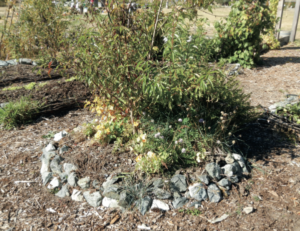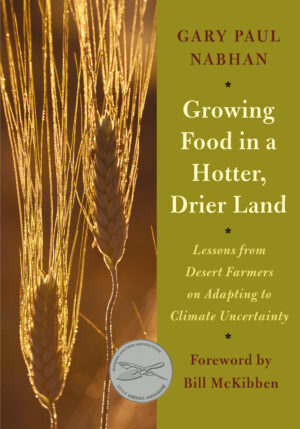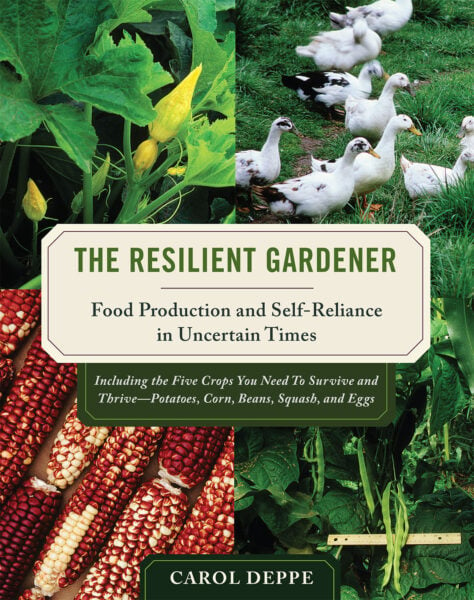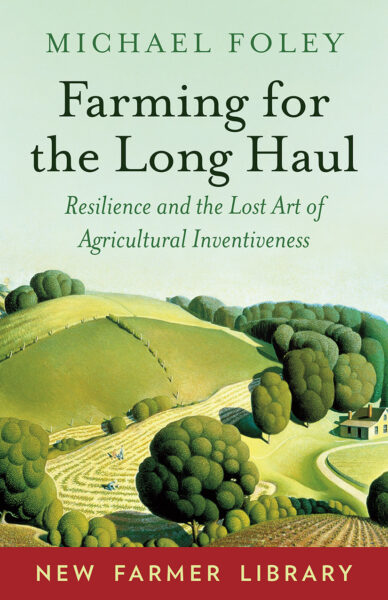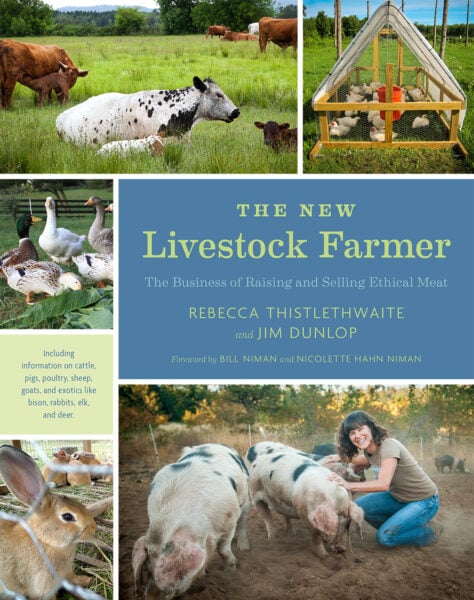Reduce Heat Stress in Crops and Livestock: Arid Agriculture
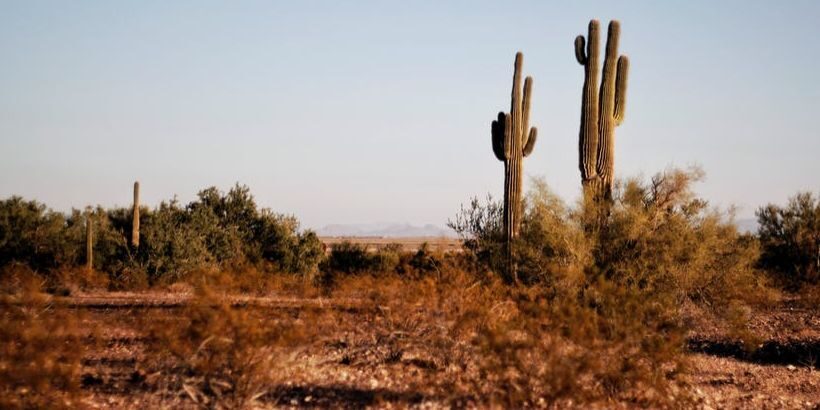
During the summer, many environments struggle with temperatures above 100˚F. These high temperatures put heat stress on crops that are not very thermotolerant. Thankfully, there are some crops that can still effectively produce food in extremely hot climates. Many farmers have found ways to build “guilds” of crops, livestock, and canopy plantings to reduce heat stress and produce food in even the most arid environments.
The following is an excerpt from Growing Food in a Hotter, Drier Land by Gary Paul Nabhan. It has been adapted for the web.
Breaking the Fever: Reduce Heat Stress in Crops
While I was spending a month in Guatemala in the early 1990s, I became aware of the fact that the concept of nurse plant guilds was well known not only in the Sonoran Desert where I was from, but in the hotter tropical reaches of Central America as well. I had spent a week trying to sleep in the sweltering heat of a multistory concrete apartment in a crowded colonia of a Guatemalan city before gaining access to a palm-thatched palapa hut in the middle of a coffee plantation.
Although the two dwellings were located less than two miles apart and shared the same macroclimate, the microclimate in the coffee plantation was at least a dozen degrees cooler by noon each day. The air-conditioning there was not built into the wall of the cone-shaped hut, but came from the palm thatch of the roof, the coffee trees around the hut, and the dense tree canopy above us.
The Impact of Nurse Plant Guilds
The cultivated tree that provided us such relief from the heat is known throughout Latin America by the name madre de cacao, mother of cocoa. It is a nitrogen-fixing legume known to scientists as Gliricidia sepium. It may now be the woody tropical plant most widely used across the world to provide “shade for cacao, coffee, and other shade-loving crops.”
Although scientists have fostered the spread of madre de cacao as a nurse plant for coffee to the many parts of the Americas, the Caribbean, Africa, Asia, and the Pacific Islands, its first use as a buffer against heat stress likely began in the Mayan-dominated reaches of Central America, where madre de cacao was first recruited to provide shade for tender young cacao plants. This must have occurred anciently, for madre de cacao is linked to both chocolate and arboreal monkeys in the ancient Mayan epic the Popul Vuh.
As historians of the Mayan agricultural landscape have written, the cacao plant became dependent upon madre de cacao trees “because it requires a fine-tuned ecosystem to survive: it is wind sensitive, sun sensi- tive, drought sensitive, and nitrogen dependent.” Were it not for the tall, shade-producing, nitrogen-fixing windbreaks and nurse plants of madre de cacao and a close cacao relative (balam-té, protector tree), we might never have enjoyed the pleasure of eating chocolate or drinking hot cocoa.
Diversity of Nurse Plants
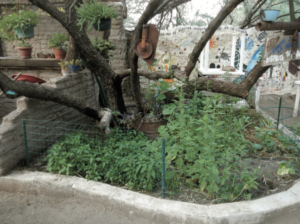
Mesquite functions as a protective nurse tree for herbs at Rancho el Peñasco Eco-Lodge in Sonora, Mexico.
While I have been impressed by the use of nurse trees as a thermal buffer for heat-sensitive crops like coffee and cacao in the tropics of Central America, it appears that the diversity and importance of nurse plants is far more striking in the deserts of North and South America. In fact, there are dozens of tree species nicknamed nodrizas or madrinas by desert dwellers, for they are absolutely essential to the germination and survival of a large portion of the edible flora growing in hot, dry climates.
Just how much difference can a nurse plant’s canopy make in protecting an understory herb or vegetable from devastating heat and damaging solar radiation? Collaborating with my Mexican colleague and former student Humberto Suzán, we once gathered a year and a half ’s worth of temperature records in the micro-environments beneath nurse trees in the Sonoran Desert.
Studying Temperature to Reduce Heat Stress
Earlier studies—undertaken well before climate change was so evident—had suggested that the dense shade of a mature nurse tree could potentially decrease the maximum soil temperature beneath it by 20 ̊F (11 ̊C) degrees on a summer day, and raise the minimum temperature by 5 ̊F (3 ̊C) on a winter day. We decided to verify those studies by measuring the soil temperature both within and beyond the understory of the desert ironwood tree, which has a dense evergreen canopy that offers continuous shade year-round.
Compared with the 115.2 ̊F (46.2 ̊C) temperature of desert soil fully exposed to the sun at noon, the soil temperature under the dense shade on the northern side of the ironwood canopy was only 95.8 ̊F (35.4 ̊C), almost 20 ̊F degrees cooler! More remarkably, the temperature of cactus stems under the same ironwood was only 94.8 ̊F (34.8 ̊C), within the range at which even pinto beans could grow and flower. The microclimate under nearby mesquite trees was nearly as well buffered as those under ironwoods, with their temperatures hovering around 98.3 ̊F (36.8 ̊C) at noon in July.
Reduce Heat Stress: Principles and Premises
One ecological principle fundamental to reducing heat stress in plants and animals is that of establishing a boundary layer between the sun and an organism vulnerable to excessive temperatures and damaging solar radiation. In most cases, the thermal buffer does not lie immediately on the skin of an animal or the surface of leaf, but it creates a layer of air between the “inner surface” of the organism and an “outer surface”—a leaf tree canopy, a latticework of feathers, hairs, thorns, spines, or fibers.
Think for a moment of the black robes worn by Bedouin nomads of the Sinai and Saharan deserts. Although you would at first guess that a dark robe would make a nomad in the desert hotter rather than cooler, the cloth itself is not pressed against the person’s skin, but forms an air space layered between the nomad’s skin and the surface of the robe, which absorbs some heat but insulates and deflects much of it away from the body.
Why Some Species Thrive in Deserts
In a similar manner, black ravens, crows, vultures, and buzzards thrive in deserts, for they have a shiny latticework of feathers that reflects the sun’s rays before they reach the birds’ skin. Similarly, some black-skinned cattle or black-fleeced sheep create a boundary layer that keeps solar radiation from driving them toward heat stress.
A nurse tree does the same, cooling the organisms in its understory during the summer and warming them in winter by establishing its own microclimate within the boundary layer beneath the tree canopy. And yet buffering underlings from extreme temperatures is not the sole service performed by nurse plants.
Benefits of Nurse Plants
Since the 1930s, desert ecologists have determined that particular nurse plants like mesquite, palo verde, ironwood, hackberry, and acacia provide a wider range of benefits than just thermal buffering to plants and animals sheltered by their canopies:
- Seeds are readily dispersed and accumulate beneath nurse plant canopies in soils where seedling recruitment will be favored.
- Canopy shade creates a boundary layer of humidity. This in turn creates a moist microclimate that buffers the underlings from death by lingering drought, catastrophic freezes, or intense heat spells.
- Organic matter under the nurse plant nurtures seedbeds with greater moisture- and nutrient-holding capacity than the surrounding desert floor, thereby fostering higher levels of germination and seedling survival.
- Shallower roots of nurse plants often inoculate the seedlings of associated underlings with mycorrhizal fungi or, if both the nurse tree and the underling are legumes, with nitrogen-fixing Rhizobia bacteria.
- Deeper nurse tree roots often pump up or lift water, macronutrients, and trace minerals used for building the plant canopy. In addition, as they shed their leaves, branchlets, and surface roots, they deposit them in the litter below the tree, where they are composted and uti- lized by other plants.
- Spines, thorns, or bristles on nurse trees repel browsers and grazers that might otherwise eat or trample developing seedlings, creating prey refugia where underling plants are protected from herbivores.
- Nurse trees provide ideal nesting or roosting sites for frugivorous birds that not only carry seeds or fruits with them, but defecate them out in nitrogen-rich packages of manure.
Some nurse plants, such as honey locust and carob, function well in semi-arid temperate zones, while others provide the greatest benefits when situated in true deserts or in the arid subtropics.
Choosing Nurse Trees to Reduce Heat Stress
A few premises will help you select nurse trees for your specific locale and your own guild of food crops:
- Not all nurse plants are created equal. Some are better than others at meeting the needs of particular crops placed in their understory. Because some nurse plants are drought- or cold-deciduous, while others are evergreen, the nurse plant guilds or micro-communities beneath them are not simply an amalgam of randomly selected parts. Studies in the Mediterranean of 11 species planted under 16 different kinds of nurse trees indicate that some underlings experience different survival rates depending upon the nurse. The deciding factor for which nurse trees may be best in any case is whether the understory plant needs protection from heat, catastrophic freezes, low soil fertility, low moisture-holding capacity, or from grazing damage by herbivores.
- The hotter and drier the environment, the greater the need for using older, well-established nurses with dense evergreen canopies that provide continuous shelter for underlings.
- The higher the risk of wild or domesticated herbivores browsing, trampling, or damaging the plants in the understory, the more important it is that the nurse plants selected have spines, thorns, barbs, or bristles to repel the animals.
- The poorer the soil, the more important it is that the nurse tree provides abundant leaf litter, fixes nitrogen, attracts mycorrhizae, and pumps water to higher levels of the soil. The permaculture concept of stacking many functions into a cohesive set of plants makes abundant sense when thinking about nurse plant guilds.
Planning & Practice to Reduce Heat Stress
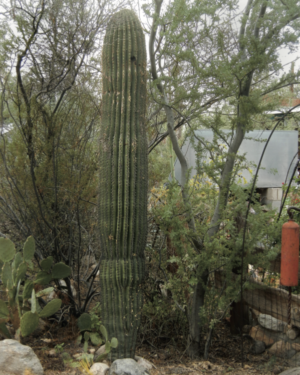
Most tall cacti in the desert, including this saguaro, begin their lives under nurse plants such as ironwood or mesquite.
Beginning around 1982, I began to imagine how we might design arid-adapted crop polycultures based on the ecological relationships found in native nurse plant guilds in the Sonoran Desert. As in other deserts, Sonoran Desert habitats feature specialized cohorts of plants that typically grow in vertical zones clustered beneath a particular shade-providing nurse tree.
For instance, under a towering ironwood tree, giant saguaro cacti might grow to heights of 15 to 20 feet, with wolfberry shrubs beneath them, prickly pear cacti beneath them, and wild onions or night-blooming cereus beneath them.
Understanding The Species
After first working to understand how particular sets of Sonoran Desert species facilitated the presence of one another in these wild nurse plant guilds, we turned our attention to designing agricultural systems based on certain guilds. Our most ambitious initiative was to use the nurse plant guild concept to grow perennial wild chiles and oreganos beneath the canopies of mesquites, feather trees, hackberries, and wolfberries.
We helped establish one commercially producing plantation of perennial chiles under legume trees between Alamos and Navajoa in Sonora, Mexico, on the southern subtropical edge of the Sonoran Desert. This field yielded an accessible harvest of fiery chiltepin peppers that campesinos mixed into their goat cheese to sell at markets as a value-added artisanal product. The feathery leaves and branches of the tepeguaje nurse trees (Leucaena leucocephala) were coppiced (pruned away) and used as forage for the goats that produced the cheese.
8 Steps to Follow When Planting
For planning and implementation purposes, the upshot of these field trials can be summarized as follows:
- Determine which combinations of understory crops and nurse trees grow best together and produce multiple benefits by evaluating natural systems nearby, or cultivated oases and other agro-forestry systems in climates comparable to your own.
- Draw a matrix of the benefits as well as the drawbacks of growing each species by itself as opposed to those of the entire guild grown together. As an experiment, grow each species by itself in a space of comparable size, and determine whether the polyculture design yields more than the cumulative harvests of the monocultures.
- Pay careful attention to establishing an appropriate height, canopy breadth, and density of the nurse plants before you introduce crops to the understory.
- Ensure that water is reaching the roots of both the nurse tree and its underlings.
- Remember to maintain an optimal density and size of the nurse tree canopy through periodic pruning, or else the understory crops may be completely shaded out.
- Shift your design and management, depending on whether or not small livestock like goats or free-ranging poultry like guinea fowl are present and require shade or forage. For instance, if goats are pres- ent, you can select shade-bearing plants whose foliage or seeds meet the goats’ nutritional needs while being hardy enough to withstand periodic browsing or grazing.
- Measure ground temperatures within the understory and outside of the canopy on barren soil each July and December, and compare results.
- Evaluate whether or not you are gaining success in stacking functions within the same space. If you are having only limited success, redesign the spacing or the species composition of the guild.
Of course, nurse plant guilds usually take multiple years to develop, and their success in reducing heat stress is very dependent upon the landscape in which they are placed.
Recommended Reads
Recent Articles
Garlic mustard: while known as “invasive,” this plant can be consumed in its entirety and has great nutritional value. Plus, the garlic-flavor is a perfect addition to any recipe that calls for mustard! The following are excerpts from Beyond the War on Invasive Species by Tao Orion and The Wild Wisdom of Weeds by Katrina…
Read MoreEveryone loves a refreshing, fermented, nutritious drink…even your garden! Take your fermentation skills out of the kitchen and into the garden by brewing fermented plant juice. The following is an excerpt from The Regenerative Grower’s Guide to Garden Amendments by Nigel Palmer. It has been adapted for the web. How to Make Fermented Plant Juice Fermented…
Read MorePeregrine falcons, while known as predators, are essential to our environment. These stunning birds have a rich history, an interesting present, and an uncertain future. The following is an excerpt from Feather Trails by Sophie A. H. Osborn. It has been adapted for the web. Who Are Peregrine Falcons? Though relatively uncommon wherever it occurs,…
Read MoreWant to see your crops thrive this upcoming growing season? The key is in soil fertility and health. Spend time maintaining your soil’s health to guarantee bigger and better crops come harvest time! The following is an excerpt from No-Till Intensive Vegetable Culture by Bryan O’Hara. It has been adapted for the web. What Is Soil Fertility?…
Read MoreMany know the effects of catnip on our feline friends, but few realize that catnip has medicinal effects for humans. From stomach aches to reducing fevers, catnip is a versatile herb with many benefits. The next time you grow this plant for your cat you may end up taking a few cuttings for yourself! The…
Read More

